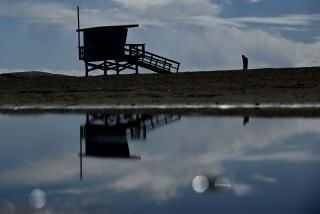Oil Pipeline Ruled Out as Source of Spill; Tar Pit Suspected
A flood of watery oil that spilled into Ballona Creek was probably runoff from a natural oil seep or a drainage system near the La Brea Tar Pits, but not from a pipeline, officials said Tuesday.
Cleanup efforts appeared to have prevented contamination of Santa Monica Bay.
Throughout Tuesday, crews plucked tar-like clumps from creek water, and state Fish and Game Department workers struggled to capture and clean soiled birds. The U.S. Coast Guard estimated that 400 to 500 gallons of oil had coursed into the creek’s concrete channel and said the cleanup will require three or four more days.
Lt. Jeanne Reincke, a Coast Guard spokeswoman, said investigators traced the spill back through a storm water runoff system to a gutter drain near the intersection of Hauser Boulevard and 6th Street seven miles northeast of the channel. There are no oil pipelines in that area, she said.
“We’ve pretty much ruled out the pipelines,” Reincke said. A final verdict in the matter was expected sometime today, she said.
Passersby on La Cienega Boulevard reported the spill Monday afternoon, although some residents along the creek said they had smelled oil for several days before.
On Tuesday, workers from Advanced Cleanup Technologies of Carson paddled after blackened lumps of debris in a flat-bottomed boat, and placed special absorbent pads over the globs before scooping them into trash bags. A day earlier, emergency workers had prevented much of the slick from moving into the ocean by stringing a series of absorbent booms across the creek. Crews have worked around the clock, vacuuming the oil waste from the surface of the water.
Officials said they narrowly averted a large-scale environmental disaster by trapping most of the slick before it moved west of Lincoln Boulevard and into Santa Monica Bay. “If it got beyond Lincoln, we’d have had a real problem,” said Tom Napoli, a scientist with the Fish and Game Department. “This was a good win for us.”
Napoli said the spill had “oiled” an undetermined number of water fowl such as mallards, coots, cormorants and grebes. Napoli said that if the spill had hit the bay, it would have affected a larger number of animals, including the federally endangered brown pelican.
Because the source of the oil may have been from a sump designed to collect natural tar and oil runoff from a neighborhood known for its oil deposits, Reincke said the owner of the cistern could be required to pay for the spill cleanup, or a portion of it. “There could be someone held at fault here,” she said.
Oil sumps are often found in underground garages or in housing developments where natural oil rests in shallow pockets. The sumps prevent oil from leaking into the structures and the collected oil can be sold to refineries. Reincke said problems occur when the sumps are not properly maintained and overflow into storm drains.
At the Los Angeles Bureau of Sanitation, spokesman Gary Moore said workers searching for the oil leak Tuesday found tar-like substances in work holes along a city-owned storm drain that originates in the 600 block of Masselin Avenue, in the tar pit neighborhood. “There’s a history of tar entering into ground water in this area,” he said.
Ballona Creek is one of the region’s major storm water channels, carrying contaminated runoff and rainwater from the streets of Los Angeles and Culver City directly into the bay at Playa del Rey. Between storms, ocean tidal water and animals move back and forth along the channel.
As cleanup workers and investigators converged at the creek’s Centinela Avenue bridge Tuesday afternoon, a bicyclist stopped to complain that he has too often seen oily rainbow puddles on the surface of the creek water. Steve Kronzer, 38, of Venice, said he rides his bike along the creek every morning. “This is not an isolated incident,” he said.
More to Read
Sign up for Essential California
The most important California stories and recommendations in your inbox every morning.
You may occasionally receive promotional content from the Los Angeles Times.











